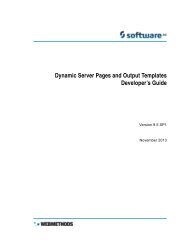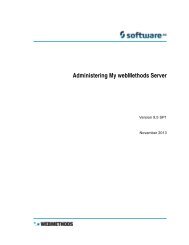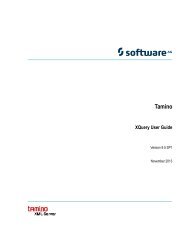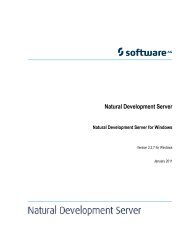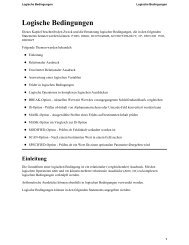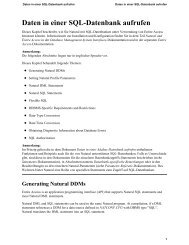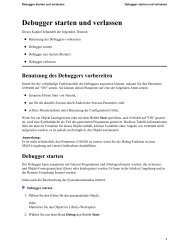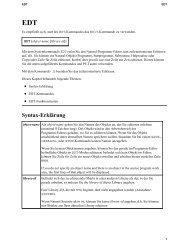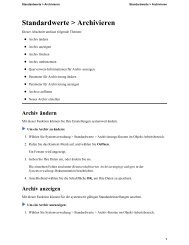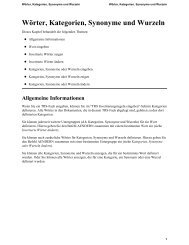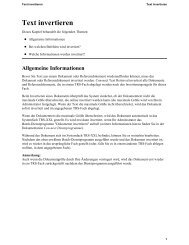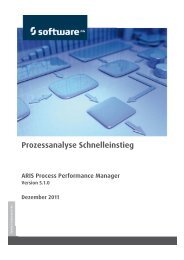Ending Entire System Server - Software AG Documentation
Ending Entire System Server - Software AG Documentation
Ending Entire System Server - Software AG Documentation
Create successful ePaper yourself
Turn your PDF publications into a flip-book with our unique Google optimized e-Paper software.
BS2000/OSD Considerations<br />
How to Start/End <strong>Entire</strong> <strong>System</strong> <strong>Server</strong> on BS2000/OSD<br />
Single-User Mode<br />
All modules required to perform an <strong>Entire</strong> <strong>System</strong> <strong>Server</strong> function are dynamically loaded into<br />
the caller's address space at request. You must therefore assign the <strong>Entire</strong> <strong>System</strong> <strong>Server</strong> Module<br />
Library to link name DDLIB2 before the Natural session is started.<br />
A startup parameter file should be assigned to link name PARMS. If not, the default values for all<br />
startup parameters are used as far as they exist. For example, the parameter PRODUCT has no default<br />
and therefore no LMS functions can be performed if no startup parameter file is assigned.<br />
The <strong>Entire</strong> <strong>System</strong> <strong>Server</strong> session is terminated when the Natural session is terminated.<br />
Multi-User Mode<br />
To use <strong>Entire</strong> <strong>System</strong> <strong>Server</strong> in multi-user mode, an <strong>Entire</strong> <strong>System</strong> <strong>Server</strong> node must have been<br />
started, that is, the <strong>Entire</strong> <strong>System</strong> <strong>Server</strong> MAIN task must have been started. All other tasks required<br />
for an <strong>Entire</strong> <strong>System</strong> <strong>Server</strong> node will then be automatically started by the MAIN task. See also Step<br />
8: Edit the <strong>Entire</strong> <strong>System</strong> <strong>Server</strong> Jobs in the Installation for BS2000/OSD documentation.<br />
Shutdown of <strong>Entire</strong> <strong>System</strong> <strong>Server</strong> on BS2000/OSD<br />
There are several ways to terminate an <strong>Entire</strong> <strong>System</strong> <strong>Server</strong> node. The usual method is to issue<br />
the console command<br />
/INTR tsn,ADAEND<br />
where tsn is the TSN assigned to the MAIN task.<br />
This will automatically end all tasks belonging to that <strong>Entire</strong> <strong>System</strong> <strong>Server</strong> node.<br />
For information on how to terminate <strong>Entire</strong> <strong>System</strong> <strong>Server</strong> via operator command, see Operator<br />
Commands in the <strong>Entire</strong> <strong>System</strong> <strong>Server</strong> Administration documentation.<br />
Another way to terminate an <strong>Entire</strong> <strong>System</strong> <strong>Server</strong> node is to issue FUNCTION= 'XEND' in the view<br />
processor NATPROC-USERS.<br />
As of Version 3.1.1 of <strong>Entire</strong> <strong>System</strong> <strong>Server</strong>, you can run the program ESYSTOP to shutdown ESY.<br />
It must be executed with the same user ID as the <strong>Entire</strong> <strong>System</strong> <strong>Server</strong>, that is, as user TSOS.<br />
The program ESYSTOP is driven by parameters obtained from SYSDTA. Job name or TSN of the<br />
ESY-MAIN task can be specified. The following syntax must be used for the parameters:<br />
118<br />
Administration



